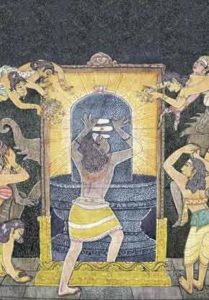 The Agamas are a class of Hindu scriptures that provide guidance on both the philosophical and the practical dimensions of worship. They include the Tantras, Mantras and Yantras. Though the Agamas are not derived directly from the Vedas, they contain essentially the same principles and are thus considered as authoritative.
The Agamas are a class of Hindu scriptures that provide guidance on both the philosophical and the practical dimensions of worship. They include the Tantras, Mantras and Yantras. Though the Agamas are not derived directly from the Vedas, they contain essentially the same principles and are thus considered as authoritative.
All Agamas deal with four aspects: (1) Gyaan or philosophical and spiritual knowledge, (2) Yoga or concentration and mental discipline, (3) Kriya or esoteric ritual including temple construction and murti sculpting and (4) Charya or exoteric worship during religious rites, rituals and festivals. In the Agamas, there are details given on topics such as cosmology, meditation, philosophy of mantras, philosophy of mystical diagrams (yantras), temple construction, religious sculpture and other rites, rituals and observances.
The Agamas can be categorised into three major groups: the Vaishnava-Agamas, the Shiva-Agamas and Shakti-Agamas. These reflect the three major sects of Hinduism i.e. Vaishnavism, Shaivism and Shaktism respectively. Vaishnavism glorifies God as Vishnu; Shaivism glorifies God as Shiva and Shaktism glorifies God as Shakti or Devi (the mother or female aspect of God). It should be noted, however, that though the main deity of the three sects is different in name and form, it is essentially the same supreme consciousness that is being worshiped in each case.
The Vaishnava Agamas are classified into four categories: the Vaikhanasa, the Pancharatra, the Pratishthasara and the Vijnanalalita. To the Vaishnavas, the the Pancharatra Agamas are regarded as the most authoritative. These are classified into seven groups: the Brahma, Saiva Kaumara, Vasishtha, Kapila, Gautamiya and the Naradiya. In total, there are two hundred and fifteen Vaishnava texts.
The Shiva Agamas are composed of twenty eight texts. These Agamas are the basis of Kashmir Shaivism in the North India (also referred to as the Pratyabhijna system) and the Shiva Siddhanta system in South India. There are also Upa-Agamas of which only twenty currently exist. Lord Shiva is the main deity that is worshipped and the system of Shaivism bears similarity to Advaitism.
The Shakti-Agamas are referred to as the Tantras. There are seventy-seven Shakti Agamas glorifying the supreme energy in a female form as the Divine Mother. These texts take the form of dialogues between Shiva and Shakti. In some cases, Shiva answers questions posed by Parvati, and in others, Parvati answers questions posed by Shiva. Popular Tantras include Mahanirvana, Kularnava, Kulasara, Prapanchasara, Tantraraja, Tudra-Yamala, Brajma-Yamala, Vishnu-Yamala and Todala Tantra.


